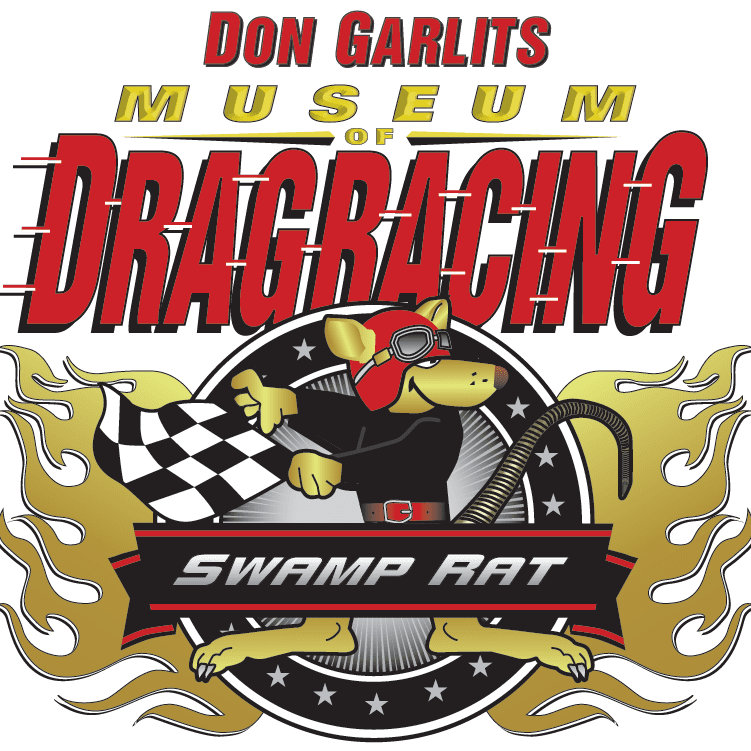2017
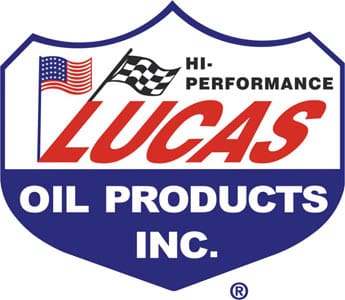
Event Sponsor Lucas Oil Products Held on Thursday March 16, 2017 Wyndham Garden Hotel, Gainesville Florida.
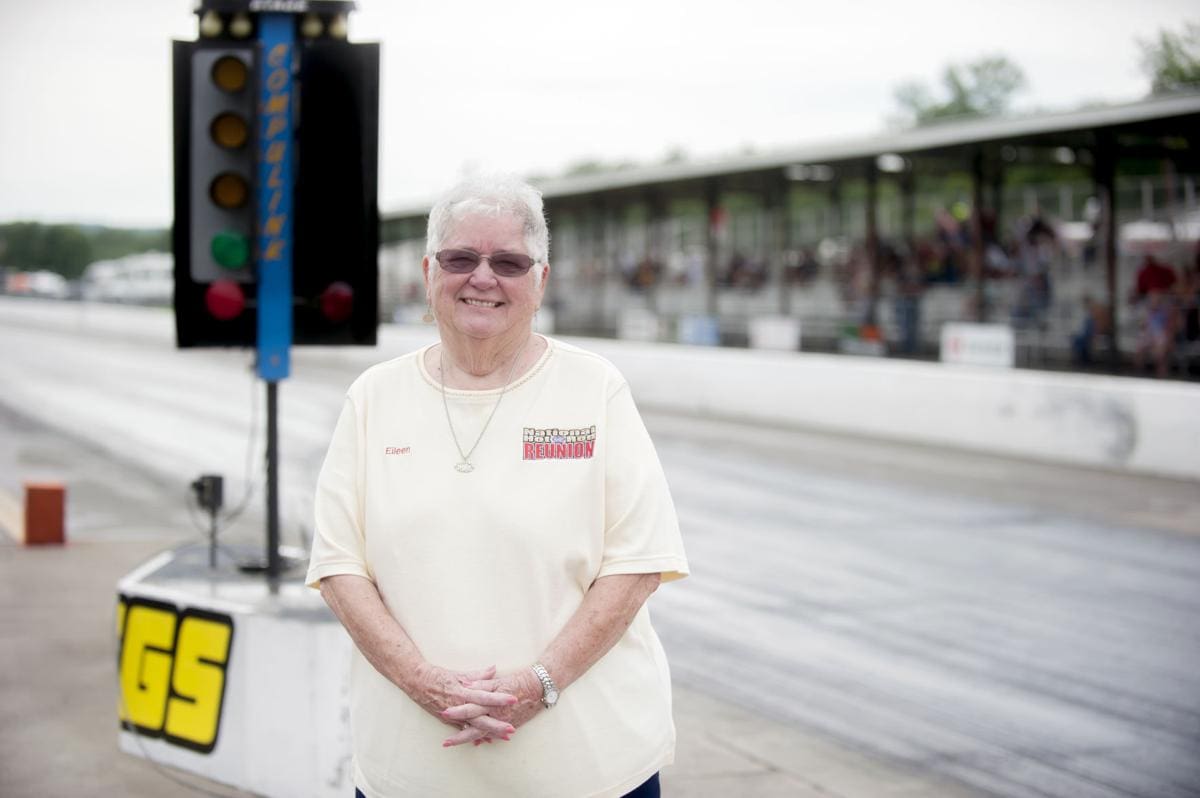
Eileen Daniels
Mopar Pat Garlits Memorial Award
Eileen Daniels a native of Marysville Ohio, has been an active participant in the growth of drag racing since she married her late husband Bob, at the age of 18. She raced with Bob in a 1932 Ford and later a Fiat and was a pioneer female racer. Wally Parks, the founder of the national hot Rod Association, liked what he saw in Bob and hired him as one of the early employees of the NHRA serving as the first director of the NHRA’s Division 3. Eileen and Bob worked as a team setting up race tracks and operating events across the Division 3 territory which encompassed: Ohio, Michigan, Indiana, Illinois, Kentucky, Missouri, Minnesota, Wisconsin, and Eastern Canada (Ontario, Québec, and Maritime Provinces). While Bob was the visible face of the NHRA to racers, track operators, and promoters in the division Eileen was the solid backup support. She handled much of the administrative and clerical duties.
Later when the NHRA purchased the Indianapolis Raceway Park facility in 1979 the Daniels team took over the operation of the facility. They expanded their horizons to include working with United States Auto Club with the weekly open wheels sprint car and midget racing at the 5/8-mile oval. Plus working with NASCAR’s Kroger 200 Bush Grand National race held before the Brickyard 400 at the Speedway. They also worked with the Sports Club Car of America for road racing events. Again, Eileen’s office management skills made her husband’s job of overall facility management much more effective.
After retiring to Florida in 1997 the Daniels team was asked to help organize a premier event for the growing nostalgia drag racing market. Using the tools that had served them so well the past, the pair worked with the NHRA and the Wally Parks/NHRA Motorsports Museum to create what is now known as the NHRA Hot Rod Reunion events. Eileen worked on the NASCAR race’s hospitality programs until the race moved to the Speedway.
After Bob’s passing in 2007 Eileen continued her role in the reunion events and has become anointed with the unofficial title of “Den Mother” too many racers to participate in events across the country. Today she remains involved hosting the “Legends” tents at events; plus organizing historic drag car displays at the NHRA Gatornationals in Gainesville, Florida, and the US Nationals in Indianapolis Raceway Park.
NHRA awarded Eileen a “Wally” trophy upon her retirement after 40 years in 1997. She shared several other awards with Bob from the NHRA in honor of their support and dedication. In 2001 she and Bob were inducted into the International Drag Racing Hall of Fame. The Indianapolis Raceway Park named the hospitality center as the “Daniels Hospitality Center”. She was named a Kentucky Colonel in 2011, and has been inducted in several other Hall of Fames. In November 2016, Eileen was honored by the British Drag Racing Hall of Fame with the title of “International Ambassador” in honor of her long career on behalf of the sport. Eileen helped to promote the sport in North America plus Great Britain, Europe, Australia, and New Zealand.

Robert J McClurg
Founder’s Award
Bob McClurg grew up in 1950’s Southern California and was a car nut long before he became an accomplished writer and photographer. As a youngster, McClurg lived around the corner from the late Jack Hart’s (heart would go on to become the first competition director for the newly formed national hot Rod Association) Orange, California based shop. Bob was working as a shoeshine boy at Town Barbershop, which was also located within walking distance from home, where he could find the latest hot Rod Magazine’s. Hart would often stop and answer questions posed by Bob.
Bob’s trial by fire happened in the summer of 1963 when Bob’s boss, slot car track operator and hobby shop owner Roger Clawson, took him to Lions Dragstrip one fine Saturday evening where Bob’s life was changed forever. Garlits was there match racing Kenny Safford, Don “Snake” Prudhomme and some other top fuel teams. The sites, smell, and incredible noise became music to his ears and he was hooked.
Bob’s very first car was a 1954 De Soto four-door sedan powered by a Fire Dome Hemi V-8 engine which he had fellow members from the “Eliminator’s Car Club of Orange” modify with multiple carburetors and a “hot cam” to make it perform better. It would have been extremely kind to have called it an actual race car.
In 1961 a Corvair 300 coupe with Bill Thompson equipped flat six for power replaced the De Soto. While it worked well as a SCCA seat of the pants, or “SOP” navigational champion for 1966 with Bob at the wheel. He wanted to become more involved in drag racing but after realizing he was never going to become a professional drag racer, he decided to try his hand as a journalist.
At age 10, Bob submitted his first newspaper article to the Orange Daily News and followed up by taking on the job of Editor at his junior high school newspaper. One night in 1964 he snuck the school camera out on the starting line at Lions and managed to fire off a roll of film before being escorted back to the bleachers by the strip photographer “Digger Ralph” Guldahl. Guildhal’s only advice, “Kid he get yourself a letter of assignment from a newspaper and I’ll let you out here!” Not long after that Bob caught up with the sports editor at the Orange Daily News and made a deal to supply the paper with regular Lions Dragstrip news and results.
While playing with cars was fun for Bob, he was soon drawn into the journalistic side of the performance world. Where he soon earned a reputation as a well-respected drag racing photographer and technical writer. After 50 years of automotive, entertainment, and industry related experience in the magazine publishing business as an editor, technical and feature writer and photographer Bob can also stake his claim as a book author; with 13 of them to his credit. In addition to his own journalistic work he has also worked as a photojournalism instructor, public relations, and advertising specialist.
Past accomplishments in the editorial realm include time spent working as a photographer and editor at Petersen Publishing’s magazines to include: Hot Rod Magazine, Custom Paint and Nody Work, Kit Car Magazine, Chevrolet Classics, Hot Rod Drag Racing, Hot Rod Mustang, and Camero Performers to name a few. Bob also served in the same capacity at McMullen/Argus Publishing Company as editor of both Mustang Illustrated and Ford High Performance magazines the latter of which he founded. Bob also contributed to the magazines including: Cars Magazine, Popular Hot Rodding, Car Craft, Super Chevy, Super Chevy Camaro, SCM Chevrolet Classics, Vans and Trucks, Street Vans, Rodder and Super Stock, Shelby Times, Cars Illustrated, Science and Mechanics. The list of magazines Bob contributed to could go on and on for several pages.
As a PR Director Bob his work for such noted companies as Lubri-Lon Inc. and the NT Yowell Pro-Stock Racing Team. It should also be noted that his contributions extended beyond the automotive arena. One such project of note was the Muscular Dystrophy Association fundraising drive held in conjunction with KENR-AM am country radio personality, the late, Hal McLean and co-founder of the Saleen Performance Parts/Leukemia Society of America “Cruising the Queen” Charity Car Show.
Still active today and living in Hilo, Hawaii, Bob is working on a couple of new books contributing muscle car and drag racing nostalgia pieces to the magazine editorial world. He also writes collector car vehicle descriptions for Mecum Auctions and most recently hosted the racer’s press conference at the 2016 British Drag Racing Association Hall of Fame.
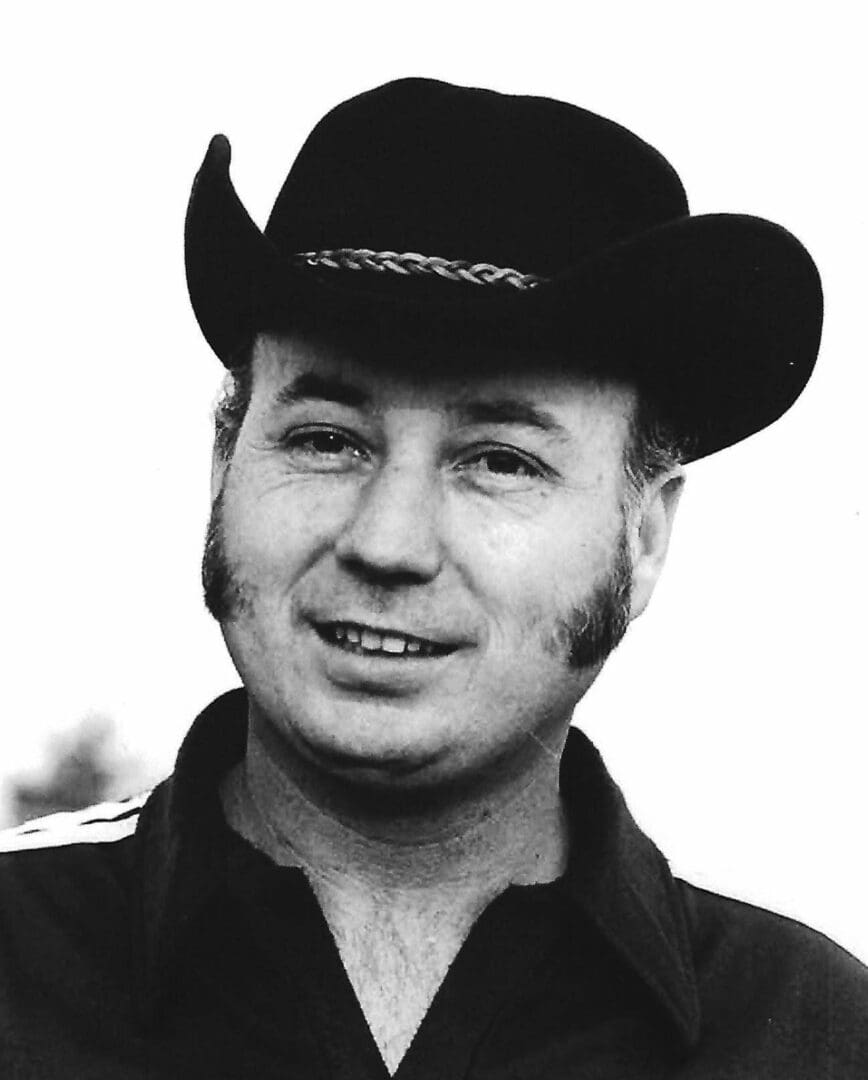
Larry Sutton
Larry loved cars and speed as long as he can remember. At age 13 Larry would ride his bike to Lions Dragstrip where he handed out time slips and where at the age of 16, he took over the job of track starter. At this same age of 16, Larry also took his first ride at the wheel of a blown Chrysler powered dragster. When it came time to close the gates at Lions forever Larry was the starter that sent the last two cars ever down the track. However, no one was anxious to leave and since it was late and just about everyone had a nip or two. When one of the locals tossed a rope around one of the outhouses and asked if anyone wanted a ride; Larry and his assistant, Bill Keys, actually became the last people to take a trip down the track.
Unlike most track officials who were either working or driving Larry would often hand over his starting duties to his assistant and make a pass and return to his starting chores when the next pair of cars lined up. Over the years he competed in almost every really hot class; driving everything from an AA/GS coupe to a blown fuel Corvette. Along the way front motor junior fuel dragsters, injected nitro funny car, the Joint Venture dragster in both Comp and Pro Comp in AA/Alcohol and AA/Fuel dragsters.
Larry’s greatest success as a driver came at the 1978 PDA meet at Orange County International Raceway when he won one of the last 32 car top fuel events ever; posting a speed of 239 MPH and an ET of 5.93 seconds. He closed 1978 out with a win at the Nitro Championships held at OCIR, in the same car, this time with the speed of 236 MPH at a 5.98 second ET. He continued competing on a part-time basis until 1990 when he posted wins at two Division 7 events in Jerry Darian and Ken Meadows blown Hemi Chrysler powered TA/Dragster.
Because of his love of the sport and experience on the starting line, after Lyons closed out in 1972, Larry continued to work the starting line at various other tracks including Irwindale, OCIR, Seattle, and Fremont.
Standing on the starting line wasn’t always easy and safe as Larry can vouch for after being struck by parts from exploding engines, hit by push cars, and even having to dodge a race car on occasion. Today Larry is retired from the racetrack world and does some camping, fishing, and traveling but from time to time he will pop up at one of the racer reunions swapping stories with his fellow retired racers.
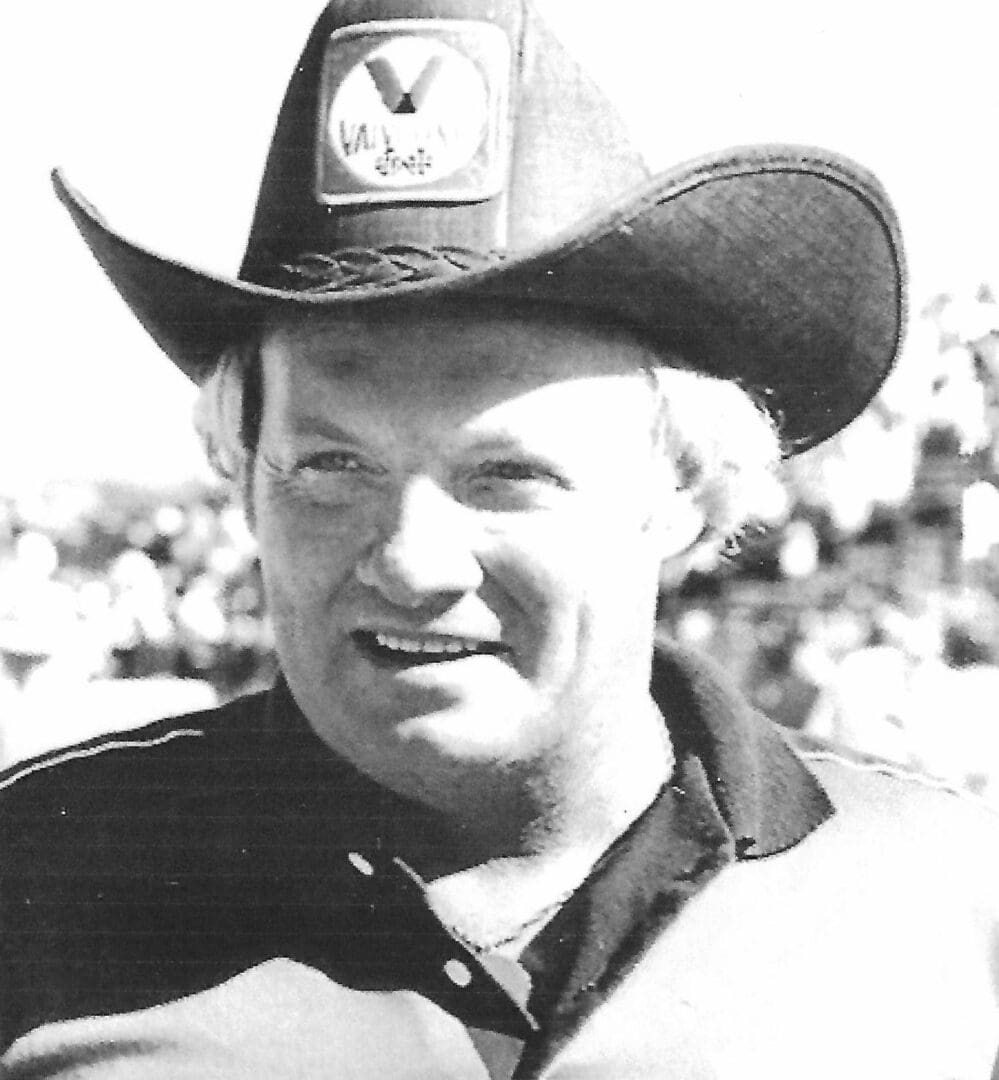
Bill Shrewsberry
Bill Shrewsberry may be best remembered as “Wild Bill” driver of the LA Dart wheel standing Dodge Dart. But before stepping into the seat he drove a series of funny cars for Mickey Thompson, Jack Chrisman, and other distinguished owners. Bill started his racing career in 1960 at Dragway 42 located in West Salem, Ohio. Shortly after that he moved to California to drive cars for Mickey Thompson. The first being one of the six factory built 421 Pontiac Tempest LeMans Coupes. His first major national win was in 1963 when he won the Winternationals at Pomona, California while driving Thompson’s Super Duty Pontiac. He was soon the dominating competitor in NHRA’s newly formed A/FX factory experimental class. In 1964 Bill one the Winternationals again but this time driving Jack Chrisman’s four-speed A/FX Mercury Comet. That same year he won a national speed record at Inoykern, California, with a 11.02 ET at 127 MPH in Thompson’s Super Duty Pontiac.
While he continued driving the factory “hot rods”, in 1965 Bill met George Hurst, inventor of Hurst Shifters, and they quickly became good friends. Hurst had designed and built what he designated to be an exhibition “rolling research laboratory” Plymouth Barracuda he named “The Hurst Hemi Under Glass”. The car was powered by an injected 426 Hemi coupled to a Hurst four-speed shifter with the engine resting over the rear end. George’s plan was to get the Hurst name in front of the racing world with the Barracuda with Bill as its driver. Bill accepted the driving assignment and the car was debuted for the very first time at the 1965 NHRA Springnationals in Bristol, Tennessee. While the plan was for “regular” exhibition runs, only after replacing the original 8-inch tires with new set of 10-inch tires, the car instantly became a wheel stander.
The car was not built as a wheel standard, but after a few runs Bill learned how easy it was to get it into a wheel stand and the decision was made to make it a real showstopper as such. With individual braking for each rear wheel; Bill was able to drive the car straight with the frontend in the air for the length of the track. Also, the original version of the car was powered by an injected aluminum Keith Black Hemi. Before long Keith convinced him to bolt a blower on top of the engine which added to it showmanship appeal and allowed the engine not to have to work so hard.
After the Hearst Hemi Under Glass, in 1966 Bill put together a program with the Los Angeles/Orange County, California Dodge Dealers Association to build a Dodge Dart which he debuted as the LA Dart. The Dart also had a 426 Hemi and body was painted with red and white stripes becoming an instant success. It was also during that time Bill met car builder George Barris. Barris was the builder of the famed Batmobile which he often displayed at various venues. George asked Bill to drive and exhibit the Batmobile at drag strips and circle tracks all over the United States; an arrangement Bill found to be both fun and rewarding when he saw how much the kids enjoyed it.
In 1970 Bill changed the LA Dart to a rear engine blown Keith Black aluminum supercharged Hemi with a Lenco two speed transmission. This added to the distance and speed the car could stay up on two wheels and the cars showmanship appeal. The LA Dart was always a showstopper and tremendously popular. Over the years there were four different LA Darts. Three were stock bodied and the fourth was a funny car body. Over the next 12 years Bill ran these cars all over the world from the United States to Canada, Mexico, Australia, New Zealand, France, Germany, and Monte Carlo.
Bill put together a program in 1980 with the Knotts Berry Farm theme park in Buena Park, California as a sponsor. He built a blown 426 Keith Black Hemi powered 1929 Ford panel delivery wagon which he exhibited throughout the Pacific Northwest, West Coast, New Zealand, and Australia until his retirement in 1988.
Always the showmen Bill never turned down a decent appearance opportunity nor the opportunity to sign autographs for the fans. Bill today remains as one of the legendary ambassadors of the sport; doing keynote speaking at club car meets, and maintaining an advisor relationship with the NHRA Museum in Pomona, California.
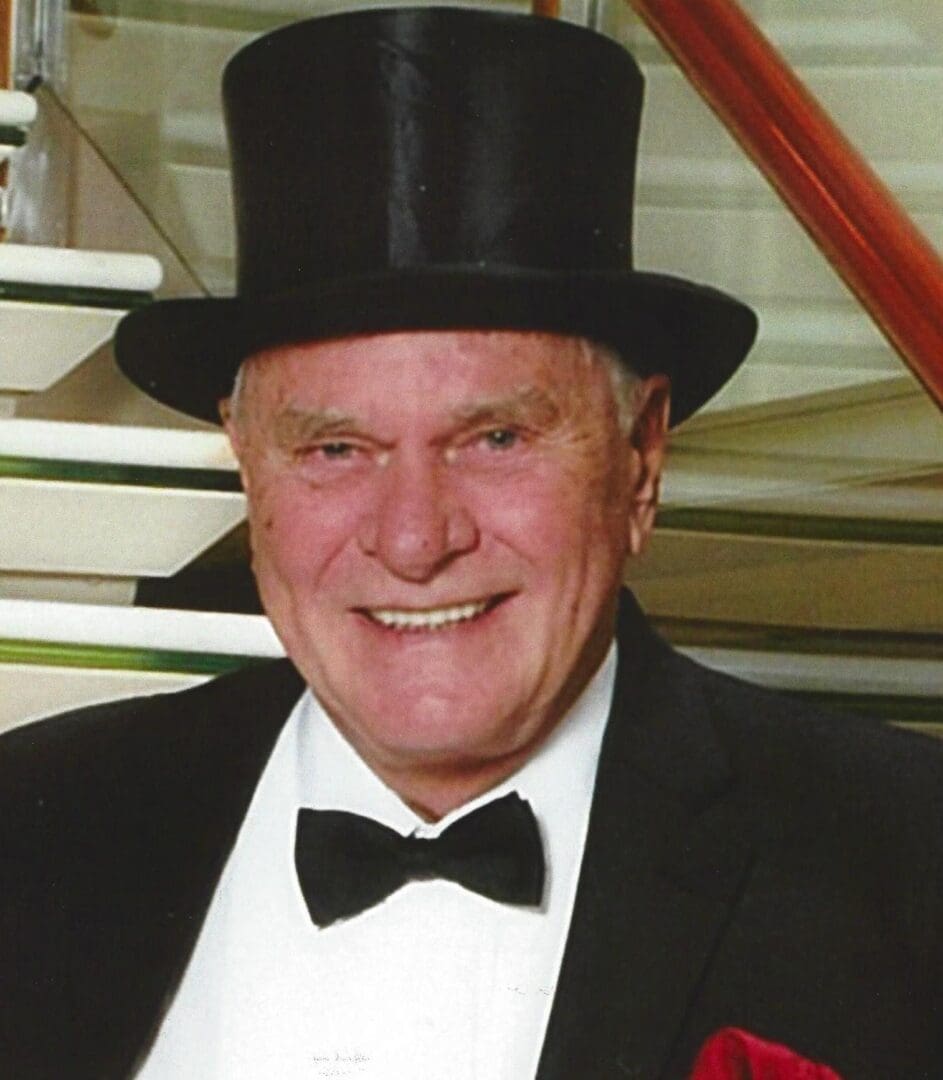
Joe Schubeck
“Gentlemen Joe Schubeck” is one of the ultimate representatives of the sport. His first introduction to cars and the sport was through the pages of Hot Rod Magazine; reading articles by future NHRA founder Wally Parks and the rest of the staff. While still in high school, Joe met a fellow enthusiast Jack Harris. Jack had started a dragster but opened a speed shop and was too busy building the business to go racing. Harris passed the dragster along to Joe and just before his high school graduation Joe debuted the nitro burning flathead V-8 powered dragster at the local race track. His very first competitive race paired him against the Arfons Brothers dragster. It was there he learned how much fun the sport was. He also learned he needed a bigger engine if he was going to be competitive.
In 1957 Joe teamed up with a fellow racer, Joe Scarpelli, with a blown Hemi Chrysler powered AA/Gas dragster that hooked him even more. It was during his early dragster career that Ed Iskenderian bestowed the nickname Gentlemen Joe on him, after which, Jim Diest made him a custom fit tuxedo driving suit. Even the bowtie was fireproof. In 1958 the two Joe’s fielded a new car that Schubeck built himself and with enough success he launched a new chassis building business named Lakewood Chassis Company. Building the chassis itself wasn’t that much of a challenge, but building the aluminum bell housing for the cars was a real hassle. After doing some research on the bell housing Joe learned of a local company that was hydroforming various parts. He wound up designing and producing a steel unit that also worked as a safety shield to contain the flywheel and clutch in the event it exploded. Because the sports acceptance of the Lakewood High Tech Bell Housing, Joe changed the name of the business to Lakewood Industries. The business became so busy Joe had to retire from actively racing.
While the business was going great. Joe really missed actively racing; when George Hurst told him about a new car he was having built. The car was an Oldsmobile 442 with two blown nitro burning engines driving on all four wheels. George asked Joe if he would be interested in driving it; it took a bit of arm-twisting but Joe finally agreed to do so. The combination of the monster car dubbed “The Hurst Harry Oldsmobile” and Joe’s showmanship, including his tux driving suit, made the venture an instant success.
Today Joe is semi-retired from the manufacturing side of the sport, producing a limited number of various specialty parts. He tours the various car shows and special events across the nation with his restored front motor AA/Fuel dragster and is a regular participant in the cackle fast events. Among Joe’s many accomplishments and honors, he was recently inducted into the prestigious SEMA Hall of Fame and remains a true ambassador of the sport.
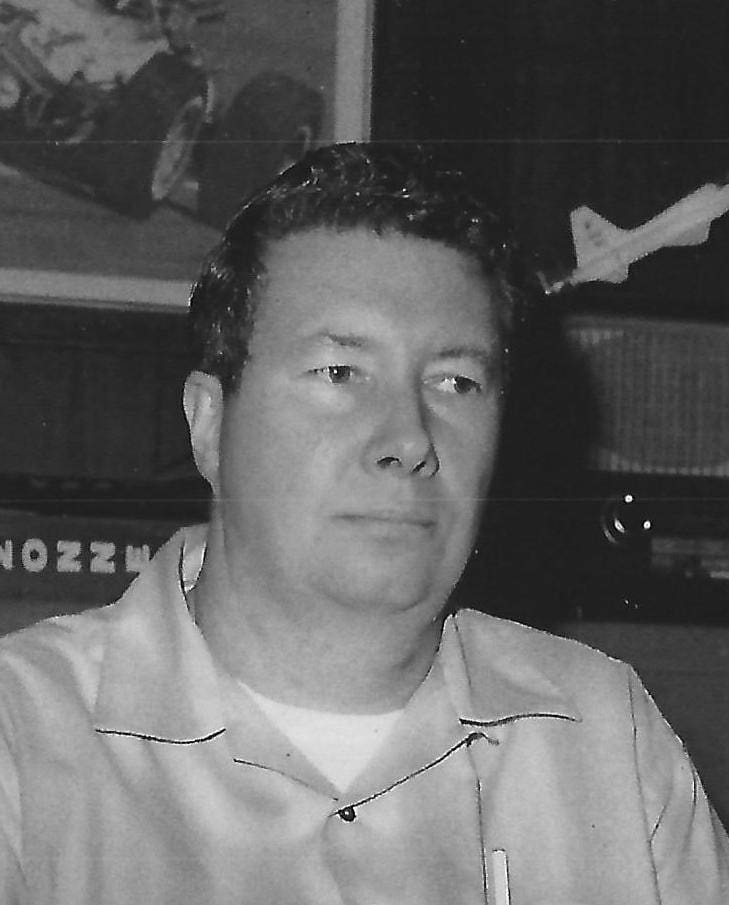
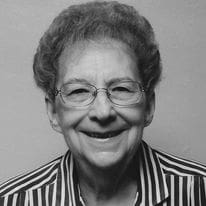
Joe Reath 1925-2013 & Dellie Reath
Joe Reath was born in Alabama but grew up attending high school and San Pedro, California where he concentrated on his studies and love of cars. Del was born in Oklahoma but finished her high school years in nearby Compton, California. The two first met in 1956, were married in October 1957, and opened the first speech shop in Long Beach California that same year.
After his discharge from the Army in 1945, Joe went to work for Earl Evans porting flathead engine’s and learning his way around operating various machines. In 1947 he changed jobs working at Douglas Aircraft in its punch press department during the day and building engines for friends at night. During this same time period, Joe was honing his racing skills at both the local drag races and the dry lakes. Like many earlier enthusiast Joe’s first car was one that he drove on the street during the week and raced on the weekends. In 1953 Joe teamed up with Harvey Haller to build a highly modified flathead V-8 powered “belly tank” for competing at the dry lakes. Harvey was killed in a crash at the dry lakes that same year and Joe purchased all of his machinery from the estate and began making plans to open a speech shop.
In 1947 Joe join the Road Runners Car Club where he rubbed elbows with fellow members that included Bob Peterson (Hot Rod Magazine founder), Wally Parks (NHRA founder), Vic Edelbrock Sr., Ray Brown, and Ak Miller to name just a few. He was also a member of the Arabs of Long Beach and the Lancers Car Club from Long Beach. It was from these men that he learned a lot about building engines, producing speed equipment, parts, and operating the speech shop.
While Joe was dating Del, he soon had her attending the local drag races with him and even got her to the dry lakes once to see what he did for fun. After Joe opened Reath Automotive, in January 1957, he and Del were married. Joe retired from racing and concentrated on building a strong reliable speed shop business. By 1965 they had outgrown the original shop and moveed to a new location at 33rd and Cherry in Long Beach. This new location gave Joe and Del an opportunity to build what Joe deemed to be the ultimate speech shop and this is where they conducted business until 1966 when they decided to downsize their operation. The move to downsize was driven by the changing times in the speed performance world, speed shops becoming large automotive parts stores, everything becoming computerized, and major corporations becoming involved.
Over the years Reath Automotive employed some of the best racers, machinist, and salespeople in the industry including: Jon Garrison, Gary Slusser, Henry Velasco, Neil Leffler, and Jerry Ballard to name a few. Reath Automotive also supplied sponsorship for a large number of outstanding racers that included: George Bolthoff, Ratican/Jackson & Sterrns, Tom McEwen, Jim Dunn, Vance Hunt, and Gordon Collette. However, Reath didn’t turn away many of the upstarts that had big dreams, but little money and gave them a lot of deep discounts for both parts and services. Joe and Del’s involvement and contribution to the sport and its many personalities has not gone unrecognized. Their honors include the following: Honoree for the Hot Rod Reunion in Bakersfield California in 1955, Honoree at the first Lions Dragstrip Reunion in 1996, and the Dry Lakes Racing Hall of Fame in 2015. Joe and Del’s contribution to the sport are second to none and will always be remembered by all involved.
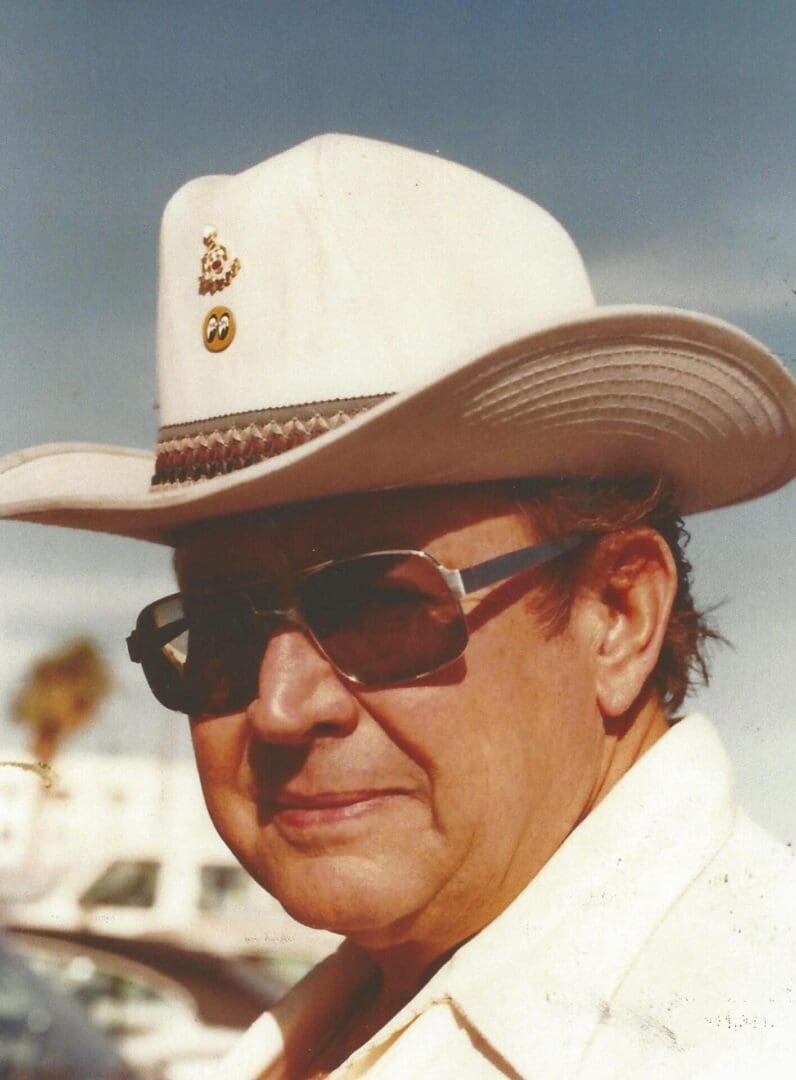
Dean Moon
Dean Moon was bitten by the “car bug” at a very early age and began planning his future while still in high school. Unlike a lot of young enthusiast of the era; Dean didn’t just want to go quick and fast he wanted to design, make and sell specially performance parts. Growing up in the Southern California community of Whittier during the 1940s put Dean in the very heart of the booming hot rod movement. Dean’s first race car was a 1932 Ford sedan which he soon began modifying for both improved performance and looks. That was followed by a 1927 T Roadster powered by a modified flathead V-8 engine and as the saying goes the rest is part of history.
Dean’s first introduction into the performance market as a manufacturer was a multiple outlet fuel block that made installing multiple carburetors much simpler. This was followed shortly by the introduction of the famous Moon Foot Pedal gas pedal. After that he seemed to be designing and producing one new product after another on a very regular basis. Still today one of the most well-known and popular products is the Moon Wheel Disc designed to not only add a sleek look to any car; it also added an aerodynamic effect helping to reduce air drag and adding top and speed.
In 1963 what is now known as Specialty Equipment Marketing Association was formed and was originally called the Speed Equipment Manufacturing Association. Dean was one of the original founders of SEMA and had a display of his products at the very first SEMA show at Dodger Stadium that same year. Dean continued to help lead the association for many years but also never stopped developing and producing new parts to help the performance minded hot rodders go quicker, faster, and safer. In addition to all these activities Dean was also a very accomplished photographer lending his talent to various publications and associations over the years.
Another of Dean’s icons are the world recognized “Moon Eyes” first introduced to the world in the mid-1950s. The lasting image was refined by artists working at the Disney Studios in 1957 and it is what is seen today.
While building the world-famous Moon Equipment Company occupied much of his time. Dean never left the racing side of the sport. In 1961 he commissioned Dragmaster to build a top gas dragster chassis that he installed a Chevy V-8 engine for power and named it Moon Eyes and proceeded to win the Indianapolis A/FD Top Fuel Championship that year. Dean was very instrumental in putting together the first United States Drag Team that toured England, parts of Europe, and even landed in Australia in 1963. His Devin bodied Moonbeam was a class record setter at the Bonneville Salt Flats in 1964 recording a speed of 206 MPH. To name a few of the cars included in the “Moon Collection” was a record-setting mini streamliner powered by a 90 cubic inch Harley Davidson motorcycle engine, an outstanding 1932 Ford coupe, and a ultra-sleek sports car.
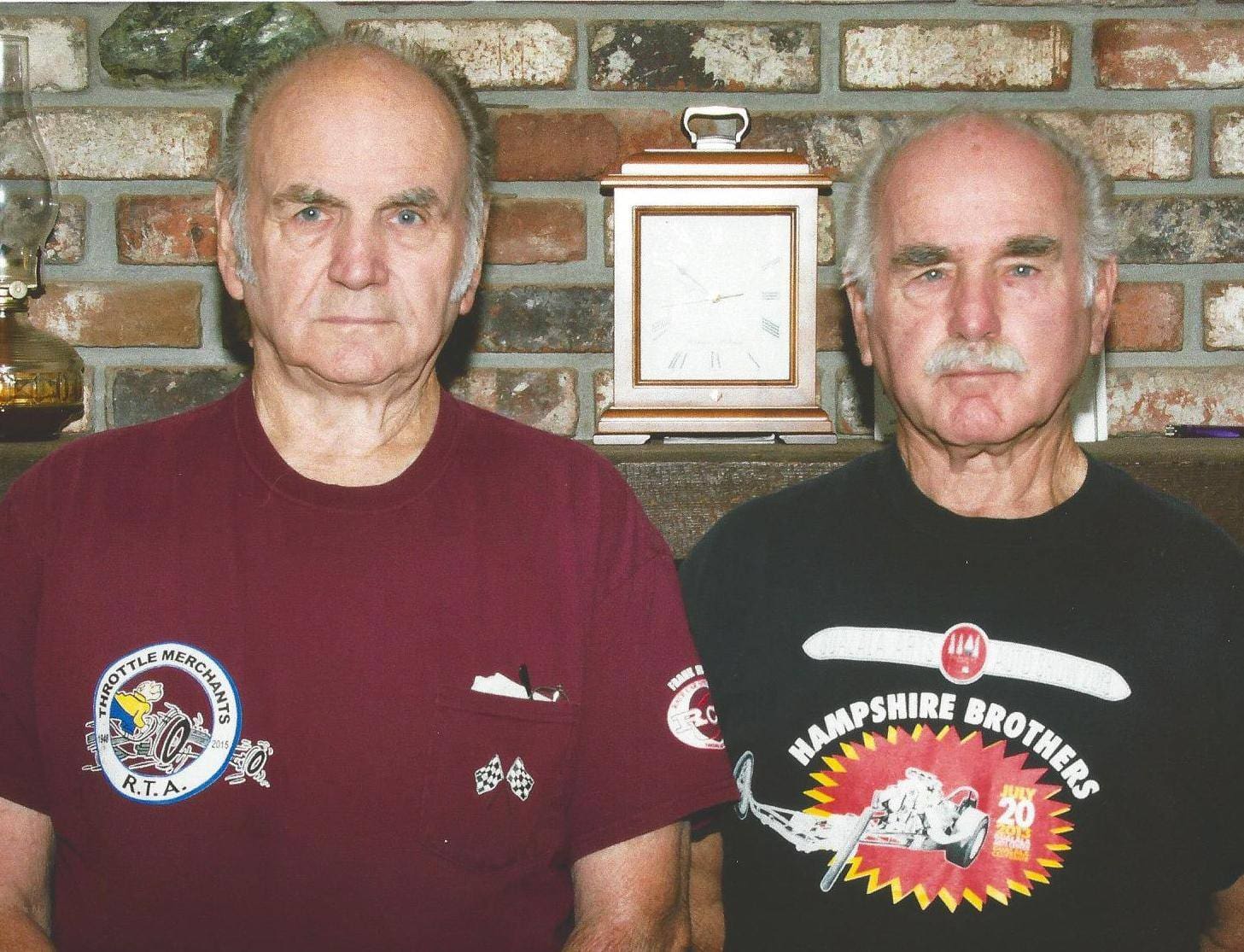
Jeep and Ronnie Hampshire
Jeep and Ronnie Hampshire brother separated by only 11 months in age, grew up sharing a love for cars and racing. Having been reared in Southern California in the 1940s and 1950s the pair was exposed to the hot rod culture at an early age and it became an integral part of their daily lives. Jeep bought his first car, a 1935 Ford, early into his high school years but finances being what they were it remained stock for as long as he owned it. Ronnie, as he recalls, drove the hand-me-downs. After their graduation from high school in 1946, the brothers went from being spectators to participants with Ronnie supplying a 1934 Ford sedan and Jeep providing a highly modified flathead V-8 for power. At the same time, they joined one of the premier car clubs of the area, the Throttle Merchants Car Club, of which they are still members some 60+ years later. In 1957 with the help of Frank Huszar and Arnie Roberts, Jeep started building his first “real” race car while the pair continued to race the 1930 Ford sedan. The brothers continued to share their common level racing and exchanged a lot of information. But as time went on, they gradually moved apart to compete on separate teams.
In 1957 Jeep started building his first dedicated race car a rear engine fully streamlined body, modified roadster with an injected Chrysler on gasoline. It was dubbed the “Platypus” due to its unusual body shape. It took him almost two years to complete this car but the first time it hit the race track it posted an incredible speed of 135 mph. After its initial appearance, Jeep teamed with Roy Steen and swapped out the unblown gas engine for a blown fuel-burning Chrysler and headed for Bakersfield California to run it. Unfortunately, on the way a drunk driver crashed into them destroying the race car.
After the “Platypus” Jeep and Roy (who is still in high school) but already an experienced welder built and drag raced a more conventional front motored blown and injected AA/FD. The Hampshire-Steen top fuel dragster experienced moderate success winning top eliminator at San Fernando and Fontana. In 1962 Chet Herbert’s had plans to build a top fuel dragster that would feature two injected F-85 Olds engines in line for power. Chet offered Jeep and Roy the opportunity to build and run the car with Chet picking up the tab for the project. In late 1962 they were able to successfully debut the car but the Hampshire-Herbert-Steen team disbanded at the end of the year over disagreements on how to run the dragster.
Not content to just sit around and spectate in 1960 Ronnie bought the original rear engine sidewinder dragster that had been built for Chuck Jones. He teamed up with George Bolthoff who was a well-known engine builder. The pair install a blown 340 CID gas burning Chevrolet engine for power. While the car looked great it was a real handful to drive. After managing to squeeze out a speed of 162 MPH and a 9.30 second ET, yet not able to correct its evil handling, the pair retired the sidewinder and teamed up with Jack Bynum to race a front engine B/Gas dragster. The next year Ronnie and George moved the blown Chevrolet into a chassis owned by Accessories LTD. and notched a few local wins with it. In 1962 the pair ordered a new Kent Fuller car but, before the new car arrived, Ronnie was dealt a big lifestyle change when he was drafted into the Army. Nonetheless he was lucky enough to be stationed at Fort Ord in Monterey, California. This allowed him to go home on the weekends. Ronnie and George would divide up the driving chores with George driving on Saturday nights and Ronnie driving on Sunday. The Army moved Ronnie to Fort Lewis near Tacoma, Washington in 1963. It was here made friends with several of the local enthusiast and managed to drive for several of them. By the time he was discharged in 1964 he and George were running a blown Chrysler in their dragster and doing so with some serious success including a stint touring around the country with it. It was at that time Ronnie got his first taste of driving and AA/Fuel dragster when he took a turn in the Ansen-Pink blown Chrysler powered nitro burner and was instantly hooked.
In 1963 Jeep briefly drove Bill Martin’s 400 Jr before securing a ride in Stellings-Graffio-Schiefer blown KB hemi powered AA/FD. Bad news came when Jeep crashed this car at Fresno when the throttle stuck wide-open and the chute failed to deploy. But the good news was Stellings would have Kent Fuller build a new car which they debuted at Lions two months later. The Stellings-Hampshire “Red Stamp Special” went out and promptly set both ends of the class record with a 7.97 second ET and a speed of 191.08 MPH. Shortly thereafter Jeep set a new ET record of 7.81 seconds at the 1964 NHRA Winternationals in Pomona, California and a Standard 1320 speed record later at Fremont with a run of 204.54 MPH.
At the end of the 1964 season the Ansen-Pink car was retired but Ronnie was able to move up to drive for Sid Waterman and Bill Brady with their unique blown Chrysler powered AA/Fuel dragster a stint that would last through 1967. This car was very unique and that the driver’s legs went under the rear end instead over it. On January 24, 1965 the team set a new Standard 1320 world record at 7.51 second ET at Fontana backing that up a week later with a 7.57 second ET at Lions. In 1968 the team replaced the durable RSC car with one of Ronnie’s own design. It featured a longer wheelbase, with a shorter front end, and with “legs over” the rear and foot controls. While building the new car Ronnie climbed into Randy Scoville’s top fuel dragster at Irwindale. Where he experienced the worst crash of his career when the steering wheel came off its shaft. He wound up bouncing off several large boulders at the top end. Ronnie was able to complete the new car and debuted it in January 1968. Because of problems that arose with Sid building engines for their competitors, and those customers not happy about him competing against them the car was sold in early 1969. While he did find a couple part-time rides after that including a short stint with Ted Gotelli. His last quality ride was the Caspary-Hampshire-Robinson top fuel dragster which was successfully campaigned from September 1969 until the end of the 1970 season when the car was sold.
In 1965 Jeep took over the driving duties of the now famous “Magic Car” of Kent Fuller, Ronnie Winkle, and Kaye Trapp. Jeep was soon posting near record times and winning several top eliminators at local tracks. But he could not come out on top at any of the big prestigious meets. In late 1965 he left the “Magic Car” to drive Glenn Stokey and Dee Caspary’s fuel dragster. But Caspary was drafted into the Army in early 1966 and the car put in mothballs. Subsequently he moved into the driver seat of the “Rainbows End” AA/FD owned by Don Kunda and Romaine Dauphine. This was a top dollar car with a Fuller chassis, Zeuschel engine, and a Tom Hanna body. Unfortunately, the owner soon ran out of money to continue racing and Jeep returned to driving for Stokey and Caspary. Dee Caspary had a new Fuller car built in 1967 and they ran it very successfully until April 1969. It was at a meet at OCIR that Jeep, on a strong pass, had a steering failure that put him into the guard rail pretty much destroyed the car and leaving Jeep with severe life-threatening injuries that ultimately forced him to retire from driving.
While the brothers are retired as drivers, they both still attend many of the California Hot Rod Reunion’s and similar events. Jeep can usually be found cackling the “Magic Car” or other cackle cars and Ronnie behind the wheel of the original Waterman-Hampshire top fuel dragster.
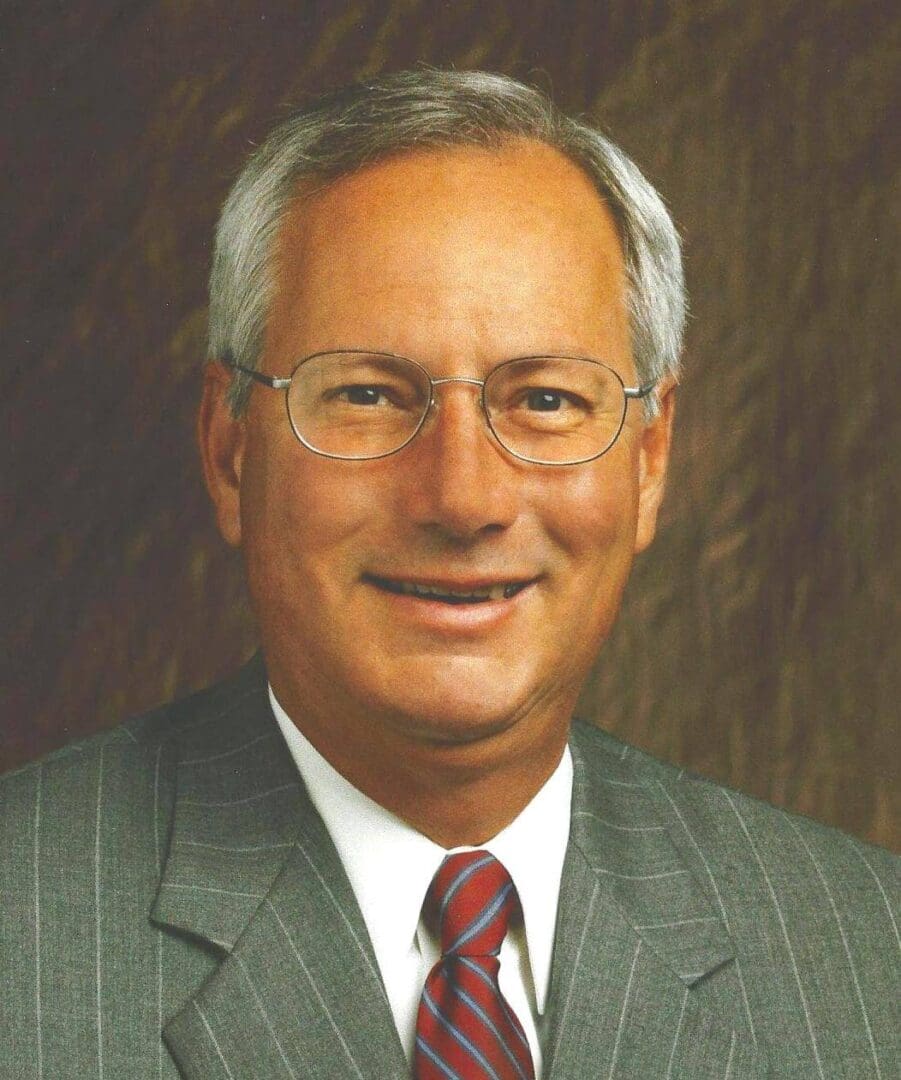
Jeff Byrd
Jeff Byrd was regarded by both his peers and the general racing enthusiast as one of the most influential track operators and promoters in all of motorsports. Growing up in Winston-Salem, North Carolina, Jeff was like most of his fellow teenagers in his interest of “really neat” fast cars. But he was more interested in the world of marketing and promotional products including high-performance cars. After graduating from Wake Forrest Universtiy Jeff went to work as a sportswriter at the Winston-Salem Journal covering the local sports world. Before long however he became involved in developing and implementing a multitude of sports that included the world of automobile racing.
In 1973 Jeff left the newspaper and went to work at R.J. Reynolds Tobacco Company as one of its marketing experts where he soon was made its Vice President of Business Development. His knowledge of both of drag racing and NASCAR enabled Jeff to propose and secure for Reynolds one of the most visible sponsorship titles ever at the nation’s leading NHRA, IHRA, and NASCAR race tracks. The sports marketing group at R.J. Reynolds was the gold standard of sponsorship activation in professional sports.
As much as he enjoyed his tenure at R.J. Reynolds in 1996 Jeff was hired by Speedway Motors Chairman Burton Smith to oversee Smith’s interest at Bristol Motor Speedway and Bristol Dragway. In this position Jeff was able to guide the facility through a total rebuild of the drag strip and a major facelift of the oval track that’s still to this day holds the record for consecutive sellouts of one of the largest venues in motorsports. Prior to this time the drags trip had operated for some time under the wing of IHRA but as the track was being renovated Jeff also returned the track to NHRA sanction.
With Jeff at the helm, the drag strip hosted two successful all-star events before joining the NHRA touring circuit as host of a national event soon dubbed the Thunder Valley Nationals. In addition to this event Jeff established and promoted several other very successful special events throughout the year at the drag strip including car shows, concerts, etc. On the oval tracks Jeff didn’t limit the use of the big stadium to just racing but made it into one that also hosts football games, concerts, and many other captivating events.
One of Jeff’s most endearing traits was his passion and friendship to the entire hot rodding/racing community. He was always available with a bit of sage advice whether it was for a racer seeking sponsorship or to help one of the sponsors get more bang for its buck. He made a lasting impact with literally every person he encountered. A major part of his success was his ability to build meaningful relationships with all of the drivers, team owners, crewmembers, sanctioning body officials, and fans within the entire racing arena. He led and lived by the mantra of “exceed expectations” which he carried through everything he did at the track and in the communities, he resided in.
In addition to receiving the International Drag Racing Hall of Fame award, Jeff has also collected a number of other honors over the years including induction into the Tennessee Sports Hall of Fame, and the Junior Achievement Business Hall of Fame. It should be noted that in 2011 the sponsor of the major NASCAR race at Bristol Motor Speedway, Food City, named the race in Jeff’s honor. Prior to his death one of Jeff’s major goals was to open BMS to a major nonautomotive event specifically the big football annual rivalry game between the University of Tennessee and Virginia Tech that would bring new customers to the venue. As testimony to his popularity with the BMS crew and local fans the game played there in 2016 set a record for spectator attendance.
